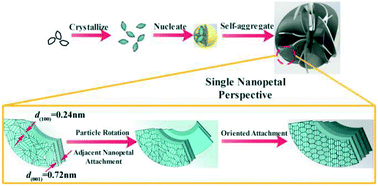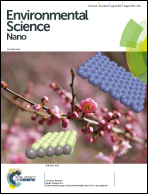Self-assembly of birnessite nanoflowers by staged three-dimensional oriented attachment†
Abstract
Birnessite (layer-type Mn(III, IV) oxides with ordered sheet stacking) is the most common mineral species of manganese (Mn) oxides and has been demonstrated to be among the strongest sorbents and oxidants in surface environments. The morphology of birnessite is one of the key factors affecting its reactivity. Either biotic or abiotic birnessite samples usually consist of nanoflower-like crystals. However, the governing factors and mechanisms of morphological evolution of the nanoflower-shaped birnessite remain poorly understood. In this work, birnessite nanoflowers, as a natural birnessite analog, were synthesized and the intermediate products during birnessite crystallization were captured by instant freezing using liquid nitrogen. The processes and mechanisms of crystal growth of birnessite nanoflowers were investigated using a combination of high-resolution transmission electron microscopy (HRTEM), field-emission scanning electron microscopy (FESEM), powder X-ray diffraction (XRD) and X-ray photoelectron spectroscopy (XPS). The results indicate that primary hexagonal nanoflakes rapidly agglomerate to form nuclei-like substrates at the initial stages, and subsequently, these nanoflakes aggregate laterally and link serially on the substrates to form nanopetals through both rotation and edge-to-edge oriented attachment (OA) mechanism. This process is likely driven by hydrogen bonding between unsaturated O atoms at the edge planes of [MnO6] sheets. Meanwhile, the OA mechanism along the (001) plane is likely driven by Coulombic interactions and hydrogen bonding during the assembly process of the adjacent nanopetals. The morphological evolution occurred by the staged three-dimensional OA process that plays an essential role in the self-assembly of flower-like birnessite crystals. These findings provide further understanding of how nanoparticle assembly is directed to achieving desired shapes and sizes by fabricating nanomaterials through three-dimensional OA processes.



 Please wait while we load your content...
Please wait while we load your content...